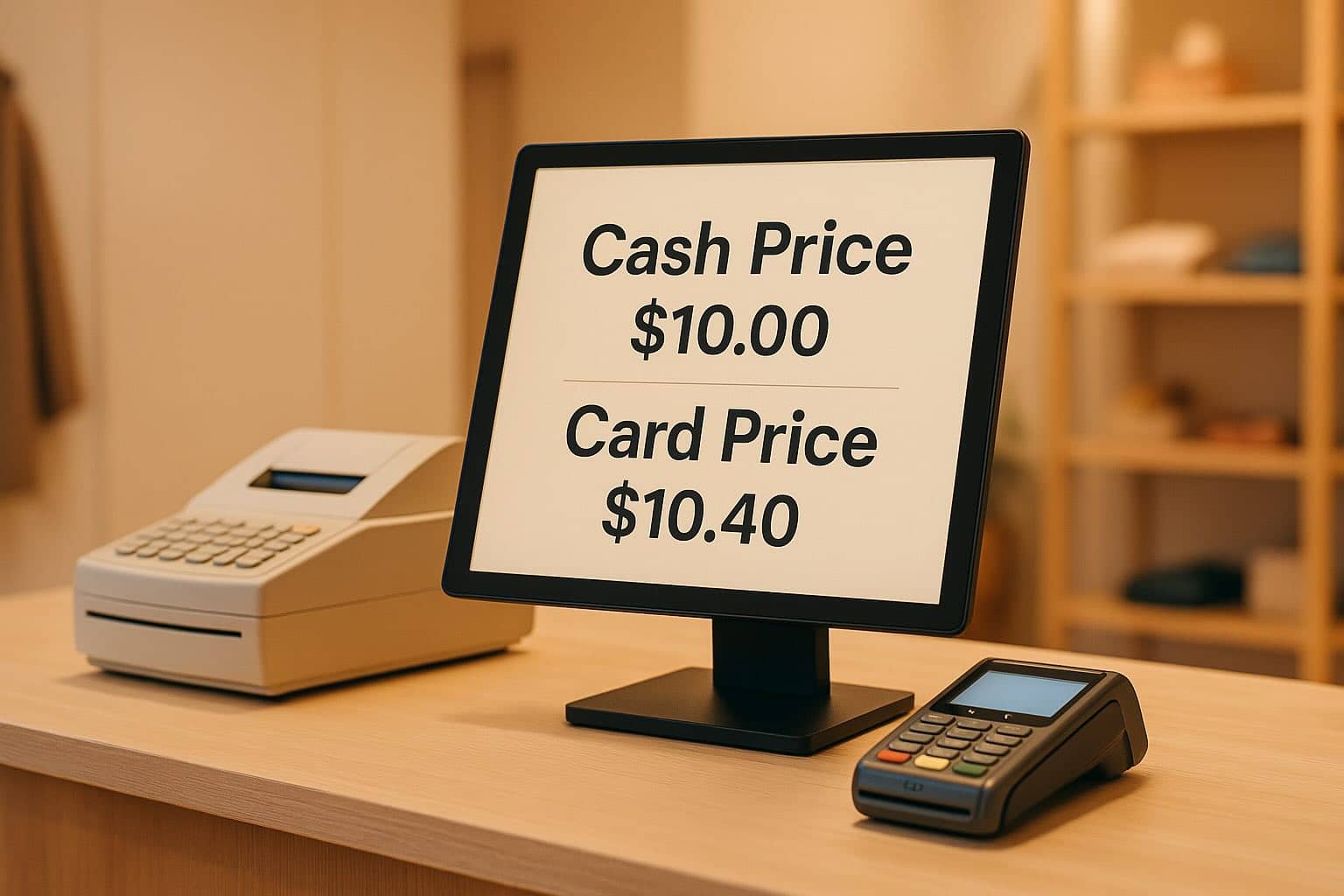For small businesses looking to manage rising card processing fees, dual pricing provides a practical and transparent solution. By offering two prices, one for cash and one for card payments, merchants can cover transaction costs without raising prices across the board. This strategy gives customers a clear choice and helps preserve profit margins.
This merchant guide explains how dual pricing works, how to implement it, and how it compares to other payment methods like traditional cash discounts. It also outlines legal and compliance requirements to help small businesses make informed decisions.
What Is Dual Pricing?
Dual pricing is a payment model where businesses display both a cash price and a card price for each product or service. The card price includes a small adjustment to cover processing fees, while the cash price offers a discount. This method gives customers the freedom to choose their preferred payment method based on transparency and cost.
How Dual Pricing Works
Setup and Implementation
To implement dual pricing, your point-of-sale (POS) system must be configured to display both prices. Receipts should clearly show the cash discount (e.g., “Cash Discount (3%): -$1.20”). Clear signage at the entrance and checkout areas is essential to explain the policy.
Pricing displays on menus, shelf tags, websites, and digital menus must reflect both prices. Staff should be trained to process transactions accurately and explain the pricing model confidently.
Dual Pricing vs. Cash Discount vs. Other Payment Models
Dual pricing differs from surcharging and cash discounting in how prices are presented and perceived by customers. In a dual pricing model, both cash and card prices are clearly displayed, for example, “$10.00 cash / $10.30 card,” which offers customers a transparent choice between payment methods. Cash discounting, on the other hand, typically involves advertising a higher base price and then applying a discount at checkout for customers who pay with cash, such as “$10.30 base price, $10.00 with cash.”
Surcharging works by adding a fee to the total at the time of payment when a card is used. This method might be seen more negatively by customers since it adds unexpected costs during checkout. In contrast, dual pricing is often perceived as more fair and transparent, while cash discounting can be framed positively as a reward for using cash.
From a compliance standpoint, dual pricing requires that both prices be visible and consistent across all sales channels. Surcharging is subject to more legal restrictions and requires additional disclosures. Cash discounting must be carefully labeled to ensure the discount is presented as such and not a penalty.
Benefits of Dual Pricing for Small Businesses
- Reduces Card Processing Fees: Card fees, typically ranging from 1.5% to 3.5%, are passed on to card users.
- Preserves Profit Margins: Helps maintain margins without increasing all prices.
- Improves Cash Flow: Cash payments are immediate, minimizing delays.
- Reduces Fraud and Chargebacks: Cash transactions carry fewer disputes.
- Attracts Price-Sensitive Shoppers: Competitive cash pricing can increase sales.
Challenges and How to Overcome Them
- Customer Understanding: Some customers may not be familiar with dual pricing. Clear signage and consistent messaging are key.
- POS System Upgrades: Choose a system that supports automatic dual pricing and receipt formatting.
- Regulatory Compliance: Ensure you follow federal, state, and card network rules.
- Staff Training: Your team must be able to explain the system confidently.
- Monitoring Results: Regularly track performance, payment method trends, and customer feedback.
Compliance Considerations
Federal and State Regulations
Dual pricing is legal in most U.S. states if pricing is presented clearly and consistently. The cash price must be positioned as a discount, not a penalty for card use.
Card Network Requirements
Card networks like Visa and Mastercard require clear display of both prices. The same rules must apply across all card brands.
Consistency in signage, receipts, and staff explanations supports compliance and customer satisfaction.
How to Get Started
- Analyze Fees: Understand your current card processing costs.
- Select Technology: Use a POS system capable of dual pricing and detailed reporting.
- Train Staff: Ensure employees understand and can communicate the pricing model.
- Update Displays: Signage, digital menus, and receipts must reflect both prices.
- Communicate with Customers: Use simple, positive messaging that emphasizes the benefit of paying with cash.
Why Use Dual Pricing?
Small businesses often operate with narrow margins and high card transaction volume. Dual pricing gives them more control over how they manage fees and serve customers. By aligning payment methods with operational goals, this strategy helps merchants maintain competitiveness and build trust with customers.
Dual pricing is an effective tool for small businesses to manage card processing fees while offering fair, visible pricing for all payment methods. With the right systems, training, and communication, merchants can adopt this model with confidence.
Dual Pricing FAQs
Q: How does dual pricing benefit small businesses?
A: It reduces card processing fees, protects profit margins, and gives customers more payment options.
Q: Is dual pricing legal in all states?
A: Most states allow dual pricing if both prices are disclosed clearly. Check your local laws to confirm.
Q: How should businesses communicate dual pricing to customers?
Use clear signage, simple language, and consistent messaging to help customers understand their options.
Q: Does dual pricing affect customer satisfaction?
A: When implemented transparently, dual pricing gives customers choice and improves trust. Customers appreciate the ability to save by paying with cash.
Q: How is dual pricing different from cash discounting?
A: Dual pricing displays both prices clearly, while cash discounting often starts with a higher base price and applies the discount at checkout.
